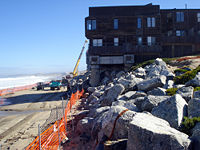Ocean Harbor House Seawall
The Ocean Harbor House was concerned over coastal erosion to their property. A seawall was erected to aid in prevent waves from impacting the structures. This page describes the process that occurred.



Contents
Background
The Ocean Harbor House is comprised of 172 condominiums and located on Del Monte Beach in Monterey,CA. It was initially constructed in the 1960's and has had various additions through the years. Because the structure was built in close vicinity to the ocean, concerns over coastal erosion, wave impact, storm surge, and property damage accumulated through the years. This led the associated homeowners to investigate protection solutions. The homeowners applied to both the California Coastal Commission and City of Monterey for a permit to construct a 585 foot seawall.[1]
Environmental Impact Report
Acting as the lead agency, the Monterey Planning Division of the City of Monterey, created an environmental impact report. It was reported that the proposed seawall would generate a peninsula effect around the structure. The sandy beach area surrounding the structure would erode leaving the structure extending out towards the ocean. This was deemed aesthetically displeasing resulting in a loss of visual character. In addition the beach would no longer be continuous preventing beach goers from full access therefore reducing recreational function and use. Despite these findings, the EIR did not find an alternative method of protection for the structure. To mitigate the loss of beach access, homeowners could allow access through their parking lot so patrons could visit the beach on either side of the structure. The City of Monterey subsequently granted a permit to the homeowners with the conditions of allowing public access through their property and creating the seawall to match the current scenery. [1]
California Coastal Commission Review
The homeowners sought approval from the California Coastal Commission after receiving the permit through the city. The CCC found that the proposed seawall would contribute to erosion and eventually an acre of beach would be lost. To mitigate this, the CCC found no opportunities for the homeowners to maintain or create a beach in the nearby area. It was recommended that a mitigation fee be used.
Beach Evaluation Methods
Three methods were recommended to denote beach value/mitigation cost:
- Sand Replacement Method
- Fee based on the price of replacing the sand: between $1,031,400 and $1,206,900
- This method failed to incorporate the value of public access and recreational beach use
- Deemed an underestimation because repeated sand replacements would be needed over the 50 year project
- Real Estate Value Method
- Fee based on comparable value of beachfront property: $1,000,000
- Used Monterey real estate sales data
- Large price variability on location of land
- Economic Recreational Value Method
- Fee based on economic studies that quantified the recreational value of the beach: $5,300,000
- Estimated recreational value of Monterey beach at $13 per person per visit
- State data showed 968,287 annual visitors
- Averaged value per acre over entire 60.6 acre beach
- Found only 870 sqft would be lost each year and calculated the 50 year total
- Fee based on economic studies that quantified the recreational value of the beach: $5,300,000
Lawsuit
The homeowners of the Ocean Harbor House sued the California Coastal Commission (CCC) over the fee imposed for the seawall installation.
Documents
- Revised Permit Application
- 11/04/2002 NOP
- 08/04/2003 EIR
- NOD
- Ocean Harbor House Homeowners Association v. California Coastal Commission
- CSUMB Review
References
Links
- ENVS 560/L Watershed Systems
- CEQA Overview
- California Coastal Commission
- CEQA projects on Central Coast
- CEQA review and land use planning
- Agencies that are lead applicants in CEQA
- List of Environmental Consultants in the Central Coast Area
- Hydrology and Water Quality Components of Central Coast CEQA Documents
Disclaimer
This page may contain students's work completed as part of assigned coursework. It may not be accurate. It does not necessarily reflect the opinion or policy of CSUMB, its staff, or students.